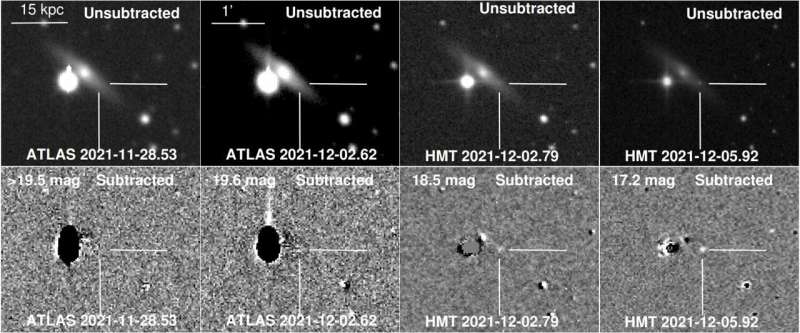October 17, 2023 report
This article has been reviewed according to Science X's editorial process and policies. Editors have highlighted the following attributes while ensuring the content's credibility:
fact-checked
preprint
trusted source
proofread
Astronomers report discovery of the closest ultrastripped supernova: SN 2021agco in UGC 3855

Astronomers report the discovery of a new ultrastripped supernova in the galaxy UGC 3855. The supernova was detected using the Half Meter Telescope (HMT) at the Xingming Observatory in China. The finding was detailed in a paper published October 7 on the pre-print server arXiv.
Supernovae (SNe) are powerful and luminous stellar explosions that could help us better understand the evolution of stars and galaxies. Astronomers divide supernovae into two groups based on their atomic spectra: Type I and Type II. Type I SNe lack hydrogen in their spectra, while those of Type II showcase spectral lines of hydrogen.
Type Ib supernovae (SNe Ib) are a subclass of stripped-envelope core-collapse SNe. They are formed when a massive star, with its outer envelope of hydrogen stripped away, collapses under its own gravity. Moreover, astronomers also distinguish ultrastripped-envelope SNe (USSNe), showing spectral features similar to those of SNe Ib/Ic, but relatively faint. In these rare SNe, the progenitor envelope has been extremely stripped before explosion.
Now, a team of astronomers led by Shengyu Yan of the Tsinghua University in Beijing, China, reports the finding of a peculiar Type Ib USSNe. The supernova was first identified with HMT on December 5, 2021 and received designation SN 2021agco.
"In this paper, we present the discovery and study of a new ultrastripped supernova, SN 2021agco," the researchers wrote.
SN 2021agco was detected at a distance of some 130 million light years, in a relatively old intermediate spiral galaxy known as UGC 3855—about 15,600 light years from the center of the galaxy. The supernova had a very fast evolution, reaching the peak of −16.06 mag within only 2.4 days after the explosion.
The study found that ejecta mass of SN 2021agco was about 0.26 solar masses and the kinetic energy of the supernova was calculated to be at a level of 95.7 quindecillion erg. The researchers estimated that the progenitor of SN 2021agco had an envelope with a radius of about 78.4 solar radii, a mass of 0.1 solar masses, and an injection energy 89.3 quindecillion erg.
According to the authors of the paper, the findings suggest that the progenitor of SN 2021agco suffered violent mass loss and the majority of its outer layer was stripped before the explosion. Based on the obtained results, they classified SN 2021agco as an ultrastripped SN Ib—the closest to Earth object of this subtype.
The observations also unveiled some information regarding the properties of the supernova's host—UGC 3855. The astronomers found that the galaxy is approximately 10.6 billion years old, has a mass of some 2.6 billion solar masses, and a relatively low star-formation rate of 0.2 solar masses per year.
More information: Shengyu Yan et al, Discovery of the Closest Ultrastripped Supernova: SN 2021agco in UGC 3855, arXiv (2023). DOI: 10.48550/arxiv.2310.04827
Journal information: arXiv
© 2023 Science X Network





















